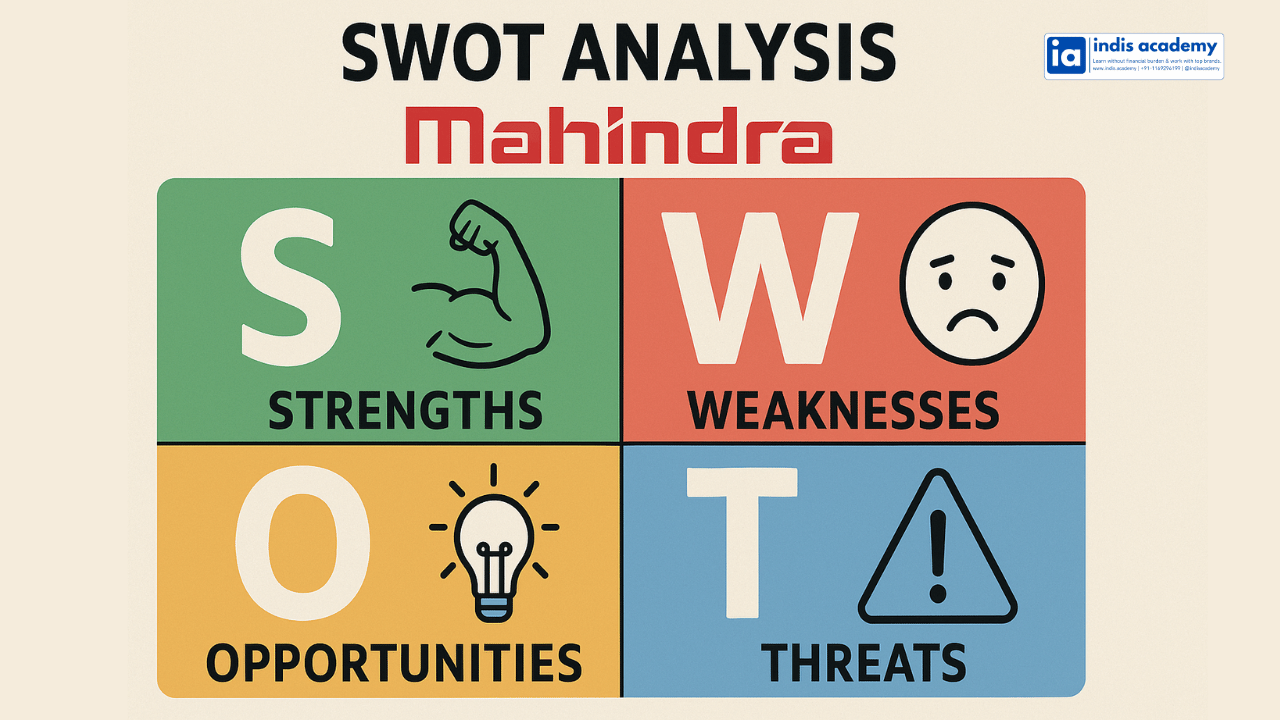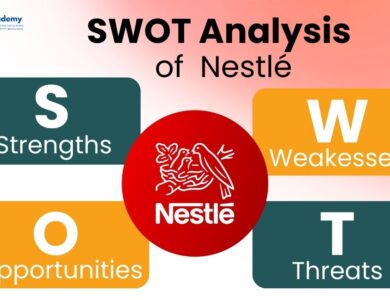Complete SWOT Analysis of Mahindra – How the Brand Continues to Lead the Indian Market

For over seven decades, Mahindra Group has been a symbol of India’s industrial growth. What started as a small steel trading company in 1945 has evolved into one of India’s largest multinational conglomerates, with a presence in automotive, agriculture, construction, IT, and more. Known for its robust SUVs and world-leading tractors, Mahindra is an essential player in both the Indian and global markets.
The company’s ability to diversify into multiple sectors, coupled with its focus on innovation and customer-centricity, has played a key role in maintaining its leadership. With its strong market share in various industries and a reputation for quality and reliability, Mahindra has set a benchmark for others to follow.
However, as markets evolve and global competition intensifies, Mahindra faces the challenge of maintaining its growth trajectory while navigating risks and external pressures.
How does Mahindra stay ahead in such a competitive landscape? The answer lies in understanding its Strengths, Weaknesses, Opportunities, and Threats.
This article will delve into a SWOT analysis of Mahindra, examining the factors that have allowed the brand to stay ahead of the curve and how it can continue to lead across different sectors.
Company Overview – About Mahindra
Mahindra Group, founded in 1945, has evolved into one of India’s most recognized and diverse multinational conglomerates.
With its roots in automobile manufacturing, Mahindra is now a leader in multiple sectors, including agriculture, construction, IT services, real estate, and financial services.
The company has been integral to India’s industrial development, bringing innovations that have revolutionized various industries, from SUVs and tractors to smart farming solutions and renewable energy technologies.
Headquartered in Mumbai, Mahindra operates in over 100 countries, with a particularly strong presence in India, Africa, Latin America, and Southeast Asia. Mahindra’s diverse product portfolio includes high-performance SUVs like the Mahindra Thar, Tractor Mahindra, e2o electric vehicles, and Susten’s renewable energy solutions.
Its reach is not just limited to automotive; it has a dominant role in agriculture, offering tractors and farm equipment to farmers globally.
Mahindra’s mission is to drive positive change in the lives of its customers by offering innovative products that improve their productivity and quality of life. With a commitment to sustainability and innovation, Mahindra continues to be a pioneering force in both Indian and international markets.
What is SWOT Analysis?
A SWOT analysis is a strategic planning tool that helps businesses assess their internal strengths, weaknesses, external opportunities, and threats.
It provides a comprehensive framework for understanding what a company does well, where it can improve, the market conditions it can exploit, and the potential risks it faces.
Components of SWOT Analysis:
-
Strengths: Internal attributes and resources that give a company a competitive edge, such as brand reputation, operational efficiency, or technological advancements.
-
Weaknesses: Internal challenges or limitations that hinder a company’s ability to achieve its objectives. These could include lack of resources, inefficient processes, or market constraints.
-
Opportunities: External factors or trends that can be leveraged to drive growth and expand the business, such as new market trends, technological innovations, or emerging markets.
-
Threats: External factors that could adversely impact the company’s performance, such as economic downturns, regulatory changes, or increased competition.
In the case of Mahindra, a SWOT analysis helps evaluate how the company’s diverse product offerings and market presence position it for continued growth and leadership.
By identifying both internal and external factors, Mahindra can adapt to changes, manage risks, and capitalize on opportunities to maintain its competitive edge in various industries.
Mahindra’s Strengths
Mahindra Group’s success across multiple sectors can be attributed to its significant strengths, which enable the company to maintain leadership positions and stay competitive in both domestic and global markets.
These strengths help Mahindra navigate challenges and continue to drive innovation and growth.
1. Strong Brand Recognition and Market Leadership
Mahindra is one of India’s most well-known and trusted brands, especially in the automobile and tractor sectors.
The company’s Mahindra SUVs, including the Thar, XUV700, and Scorpio, have gained a strong following for their ruggedness, reliability, and off-road capabilities. In the tractor segment, Mahindra is the world’s largest manufacturer of tractors by volume, making it a trusted name in agriculture across India and emerging markets.
2. Diversified Business Portfolio
Mahindra’s diversified operations across industries such as automotive, agriculture, IT services, real estate, and financial services provide significant business stability.
By having interests in multiple sectors, Mahindra is able to hedge against risks in any one industry. For example, while the automobile market faces competition and economic volatility, Mahindra’s agricultural equipment and financial services segments remain strong and stable, providing alternative revenue streams.
3. Focus on Innovation and R&D
Mahindra places a high emphasis on research and development to foster innovation across its product lines.
The company has pioneered the development of electric vehicles like the e2o and eVerito through its automotive division. In addition, Mahindra’s Susten division is involved in solar energy and sustainable farming solutions.
By focusing on green technologies, Mahindra is positioning itself as a future-ready brand that aligns with global trends in sustainability and clean energy.
4. Strong Presence in Rural and Emerging Markets
Mahindra’s dominance in rural India, particularly with its tractors and small commercial vehicles, gives it a significant edge over competitors.
The company has tailored its offerings to meet the specific needs of rural consumers, from affordable pricing to durability in tough conditions. In addition, Mahindra’s international reach in markets such as Africa, Latin America, and Southeast Asia provides it with substantial opportunities for growth in regions where infrastructure development and urbanization are on the rise.
5. Robust Distribution and Service Network
Mahindra has an extensive distribution network in India and across the globe, ensuring that its products are widely accessible. With over 3000 dealerships and a strong service network, Mahindra ensures that customers have easy access to products, spare parts, and services.
This extensive network also enhances brand loyalty, as customers feel more confident in buying and servicing Mahindra products due to the accessibility and reliability of support.
These strengths have allowed Mahindra to maintain a leadership position in the automobile and tractor industries, while also expanding its reach into newer sectors such as renewable energy and digital transformation.
By leveraging its diversified business model, innovation capabilities, and strong market presence, Mahindra is well-positioned to maintain its leadership across multiple industries.
Mahindra’s Weaknesses
Despite its market leadership and success, Mahindra faces several internal challenges that could impact its future growth. These weaknesses need to be addressed for the company to maintain its competitive edge and continue thriving across its diversified business segments.
1. High Dependency on the Indian Market
Although Mahindra operates in over 100 countries, a significant portion of its revenue still comes from India. This over-dependence on the Indian market exposes Mahindra to risks tied to economic fluctuations, policy changes, and market saturation in India.
For example, any slowdown in India’s automobile sector or changes in agricultural policies could negatively affect Mahindra’s performance.
2. Limited Presence in the Premium Car Segment
While Mahindra has an established presence in the SUV and tractor markets, its offerings in the premium car segment are limited.
Competing with global giants like Toyota, Mercedes-Benz, and BMW in the high-end automobile market remains a challenge. Mahindra’s vehicles, such as the XUV700, have gained popularity, but it still lacks the depth in the luxury segment compared to some of its competitors, limiting its market share in the premium space.
3. Profit Margins and Cost Pressures
Despite its wide range of products and services, Mahindra faces profit margin pressures due to high production costs in some of its segments.
For example, automobile manufacturing requires significant investments in technology, research, and raw materials, which can reduce profitability, especially when the company is forced to offer discounts or promotions to remain competitive. Additionally, fluctuations in the prices of raw materials like steel and aluminum affect Mahindra’s production costs.
4. Brand Image Dilution
As a diversified conglomerate with operations spanning across automobiles, real estate, agriculture, and IT, Mahindra’s brand image could sometimes be perceived as less focused.
The company must work on maintaining a cohesive identity that ties together its various businesses while ensuring it doesn’t lose its appeal in any one sector. This broad diversification, while a strength in many ways, could also lead to challenges in terms of brand positioning.
5. Operational Efficiency and Delivery Delays
As Mahindra expands its product offerings across industries, managing operational efficiency has become more challenging.
Delivery delays, especially in the automobile and tractor segments, can lead to customer dissatisfaction and hurt the company’s reputation. Furthermore, supply chain disruptions, particularly in global markets, can hinder Mahindra’s ability to meet demand and maintain service quality.
6. Exposure to Volatility in the Agricultural Sector
Mahindra is a dominant player in agriculture through its tractor manufacturing and farm equipment businesses. However, this sector is highly vulnerable to climatic conditions, government policies, and global commodity price fluctuations. Poor harvests, rural economic instability, or changes in subsidy policies could impact Mahindra’s agricultural business and its performance in rural India.
These weaknesses highlight areas where Mahindra must improve its international diversification, premium offerings, and operational efficiency. Addressing these internal challenges will allow Mahindra to remain agile and competitive as it faces external market pressures.
Mahindra’s Opportunities
As one of India’s largest conglomerates, Mahindra Group has several opportunities to capitalize on market trends, expand into new sectors, and continue growing its global footprint. Here are some of the key opportunities that can drive Mahindra’s future growth:
1. Growth in Electric Vehicles (EVs)
The electric vehicle (EV) market is rapidly expanding, and Mahindra has already made strides in this space with models like the e2o and eVerito. As governments across the globe increasingly focus on sustainability and carbon reduction, the demand for electric vehicles is expected to grow significantly.
Mahindra has the opportunity to expand its EV portfolio and become a leader in affordable electric mobility in both India and emerging markets.
2. International Market Expansion
Mahindra has a strong presence in emerging markets like Africa, Latin America, and Southeast Asia, but there is room for further growth. These regions are experiencing rapid urbanization, infrastructure development, and increased demand for mobility and agriculture solutions.
Mahindra can capitalize on this demand by expanding its automotive, tractor, and agri-tech solutions in these markets. This diversification into new geographies will help reduce its dependence on the Indian market and provide new revenue streams.
3. Smart Farming and AgriTech Solutions
With India’s growing focus on modernizing agriculture, Mahindra’s smart farming solutions have great potential.
The company’s Mahindra Tractors and agricultural equipment are already well-established, but there is significant growth potential in precision farming, IoT-powered equipment, and sustainable agricultural practices. AgriTech solutions that improve crop yields, reduce waste, and promote sustainable farming can position Mahindra as a global leader in the agriculture innovation space.
4. Digital Transformation and IT Solutions
Mahindra has a strong foothold in the IT services sector through Tech Mahindra, which provides digital transformation, cloud computing, and IT consulting.
As businesses worldwide continue to adopt digital technologies, Mahindra can further expand its enterprise solutions offerings, tapping into the growing demand for cybersecurity, cloud storage, and AI-powered business solutions.
By investing in emerging technologies like artificial intelligence and blockchain, Mahindra can lead the digital transformation across multiple industries.
5. Growth in the Agribusiness Sector
The global demand for food is rising, and with Mahindra’s leadership in the agricultural machinery and farm equipment sector, the company is well-positioned to capitalize on this trend.
Mahindra can expand its presence in agri-business services, such as food processing, storage solutions, and supply chain management. This offers a huge opportunity to cater to the needs of small and medium farmers globally, especially in developing countries.
6. Focus on Renewable Energy and Sustainability
With a growing emphasis on sustainability and clean energy, Mahindra can continue to strengthen its renewable energy division through solar power and electric mobility solutions.
Its Mahindra Susten division is already a key player in solar energy solutions, and there’s significant room for expansion in both solar installations and sustainable infrastructure projects. As governments and businesses increasingly focus on green energy, Mahindra has a unique opportunity to become a leader in the sustainability sector.
7. Expansion in Real Estate and Affordable Housing
As urbanization accelerates in India and other emerging markets, Mahindra’s presence in real estate through Mahindra Lifespace Developers offers growth potential.
The company can focus on the affordable housing segment, which is seeing increasing demand in India due to government initiatives and urban growth. Additionally, Mahindra can expand its presence in smart cities, urban planning, and green building solutions, leveraging its diverse expertise to create sustainable living spaces.
By leveraging these opportunities, Mahindra can diversify its revenue streams, expand into new markets, and capitalize on emerging trends. Whether it’s in electric mobility, agriculture, or renewable energy, Mahindra’s ability to adapt to changing market demands will be crucial for its future success.
Mahindra’s Threats
While Mahindra has a robust market presence and strong growth prospects, it is not immune to external threats that could impact its performance across various sectors. These challenges are crucial for the company to address in order to maintain its leadership position and stay competitive in the rapidly changing market landscape.
1. Intense Competition
The automobile and tractor markets in India are highly competitive, with numerous domestic and international players vying for market share.
Mahindra faces competition from domestic giants like Tata Motors, Maruti Suzuki, and Hero Motors, as well as global automakers such as Ford, Toyota, and Honda. In addition, the entry of new electric vehicle (EV) manufacturers and global players such as Tesla could intensify competition, especially in the electric mobility segment.
In the tractor market, Mahindra competes with John Deere, Sonalika, and New Holland, while global agritech companies are beginning to introduce technologically advanced equipment for small farmers. The pressure to innovate while keeping prices competitive may affect profitability.
2. Economic Downturns and Market Volatility
Mahindra’s diverse operations across automotive, agriculture, and real estate make it sensitive to economic cycles. Economic slowdowns, high inflation, and recessionary pressures can hurt demand for SUVs, tractors, commercial vehicles, and real estate projects.
In particular, rural demand for tractors could be negatively impacted by poor agricultural yields or financial instability in rural areas. Moreover, economic fluctuations can affect consumer spending, leading to lower sales in non-essential sectors like automobiles and real estate.
3. Regulatory and Compliance Risks
Mahindra operates in highly regulated industries, particularly automobile manufacturing, financial services, and real estate development.
Changes in government regulations, environmental policies, and taxation laws could impact Mahindra’s operations. For example, emission norms and safety standards in the automobile industry are becoming stricter globally, requiring heavy investments in R&D and product redesigns to comply with these regulations.
Similarly, land acquisition laws and zoning regulations in the real estate market can increase operational costs and cause delays.
In addition, import duties and trade restrictions could impact the cost of raw materials and component sourcing for Mahindra’s automobile manufacturing units, especially if global supply chains face disruptions.
4. Technological Disruptions and Innovation Cycles
In the fast-evolving world of technology, Mahindra must constantly innovate to keep up with technological advancements in areas like electric vehicles (EVs), autonomous driving, smart farming, and renewable energy solutions.
If Mahindra fails to adapt to emerging trends or cannot invest heavily in R&D, it risks falling behind competitors. The shift to digital transformation and AI technologies in automotive manufacturing and agriculture could pose a threat if Mahindra does not integrate these innovations quickly enough.
For instance, the shift towards autonomous vehicles and EVs by global car manufacturers means Mahindra needs to invest in these technologies, which could affect its existing business lines and profit margins.
5. Cybersecurity and Data Privacy Concerns
As Mahindra increases its focus on digital transformation, online platforms, and customer data, the threat of cybersecurity breaches and data privacy concerns grows.
A major data breach could severely damage Mahindra’s reputation and consumer trust, especially as customers become increasingly concerned about their personal data. Additionally, the company’s IT services arm, Tech Mahindra, is exposed to risks related to cyberattacks, which could result in significant financial losses and a decline in client confidence.
6. Environmental and Sustainability Pressures
With growing environmental concerns, Mahindra is under pressure to ensure its operations and products are sustainable and eco-friendly. Governments, investors, and consumers are increasingly demanding that companies adopt green manufacturing practices, reduce carbon footprints, and offer eco-friendly products. While Mahindra has made strides in this area through its electric vehicles and solar solutions, it must continue to focus on reducing emissions, improving fuel efficiency in its automobile fleet, and making its operations more sustainable to meet both government regulations and consumer expectations.
These threats illustrate the external challenges Mahindra faces across its diverse sectors. To stay competitive, Mahindra must adapt to technological shifts, navigate economic uncertainties, and address regulatory changes while continuing to lead in innovation and sustainability.
Competitive Strategy & Future Outlook
Mahindra’s success across diverse industries can be attributed to its robust competitive strategy that focuses on innovation, diversification, and global expansion. The company has consistently adapted to evolving market trends, consumer needs, and technological advancements. Let’s look at Mahindra’s key strategic initiatives and its future outlook.
1. Investment in Electric Vehicles (EVs) and Sustainable Mobility
As global demand for electric vehicles (EVs) continues to grow, Mahindra has positioned itself as a key player in the affordable electric mobility space. The company’s e2o and eVerito electric vehicles are an example of its commitment to green transportation. In addition to electric passenger vehicles, Mahindra is also focused on developing electric commercial vehicles and electric tractors. By investing in sustainable technologies and expanding its EV portfolio, Mahindra can capitalize on the growing demand for eco-friendly transportation solutions, both in India and globally.
2. Expansion into Global Markets and Emerging Economies
Mahindra has already established a strong foothold in India, but it continues to look for opportunities to expand in emerging markets like Africa, Latin America, and Southeast Asia. These regions present massive growth potential for Mahindra’s automobiles, tractors, and agricultural solutions. By tapping into the growing middle class and rising demand for affordable, durable vehicles and agri-tech solutions, Mahindra can diversify its revenue streams and reduce its dependence on the Indian market.
3. Focus on Smart Farming and Agritech Solutions
The global agricultural sector is undergoing a digital transformation, and Mahindra is well-positioned to lead this shift with its agriculture-focused technologies. Through Mahindra Susten and Mahindra Tractors, the company is investing in smart farming solutions, such as precision farming, IoT-powered equipment, and sustainable farming practices. As the demand for food production efficiency rises globally, Mahindra can expand its agribusiness and offer innovative products that help farmers improve productivity while reducing environmental impact.
4. Emphasis on Sustainability and Green Initiatives
Sustainability is becoming increasingly important to consumers, investors, and regulators. Mahindra is committed to being a leader in green business practices, focusing on eco-friendly manufacturing, renewable energy, and sustainable product offerings. The company’s solar energy solutions through Mahindra Susten and its focus on low-emission vehicles show its commitment to a sustainable future. By continuing to prioritize sustainability in product design, manufacturing, and operations, Mahindra can strengthen its position as a responsible corporate entity.
5. Strategic Acquisitions and Partnerships
To fuel growth and expand its capabilities, Mahindra is focusing on strategic acquisitions and partnerships. By acquiring companies in tech innovation, electric mobility, and agriculture technology, Mahindra can integrate new technologies and extend its offerings. Additionally, partnerships with key players in global markets can help Mahindra expand its product range, enter new regions, and access cutting-edge technologies to stay competitive.
6. Leveraging Digital Transformation and Technology
Mahindra is embracing digital transformation across all of its sectors, from automobile manufacturing to agriculture. By integrating artificial intelligence (AI), machine learning (ML), and data analytics, Mahindra can improve product development, streamline operations, and deliver personalized customer experiences. The company is also focusing on IoT and smart technology to create connected products that offer enhanced functionality, efficiency, and value. Mahindra’s Tech Mahindra division is also leveraging IT solutions to support global clients in their digital transformation journey.
Conclusion & Final Thoughts
Mahindra Group’s journey from a small steel trading company to one of India’s most influential conglomerates has been marked by innovation, diversification, and market leadership. With its strong presence in industries such as automobiles, agriculture, IT services, and renewable energy, Mahindra has established itself as a global powerhouse that continues to adapt and thrive in an ever-evolving market.
The SWOT analysis of Mahindra reveals a company that is well-positioned for future growth, especially in areas like electric mobility, agribusiness, and global expansion. Its brand recognition, diverse product portfolio, and commitment to sustainability give it a competitive edge in both the Indian and global markets. However, challenges such as intense competition, economic slowdowns, and regulatory risks must be managed carefully to ensure long-term success.
By continuing to innovate and embrace new technologies, Mahindra is poised to maintain its leadership across multiple sectors. The company’s focus on sustainable practices, global expansion, and smart farming ensures that it remains relevant in an increasingly digital and eco-conscious world.
In conclusion, Mahindra’s diversified strategy, commitment to innovation, and focus on sustainability will help it maintain its leadership position and continue driving growth in the coming years.





